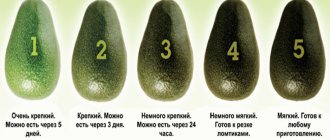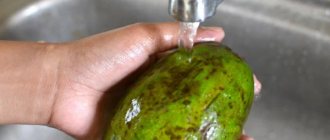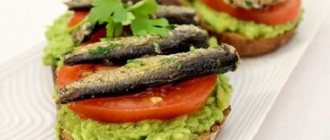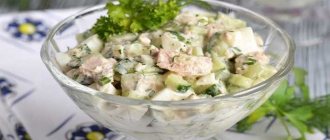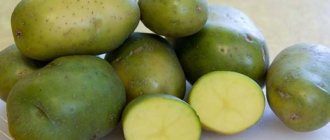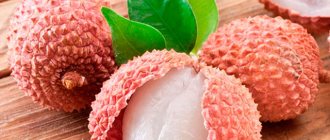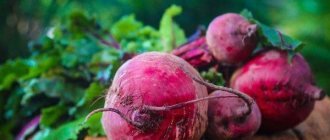What does a spoiled avocado look like inside?
Now I will teach you how not to buy bad Ettinger avocados and how to distinguish them from good ones. Sellers often pass off spoiled Ettingers as good ones, those with a cheese, creamy or mushroom taste, and which also don’t look very attractive. But bad, spoiled avocados are usually distinguished not by wrinkles, but by individual dark spots, often even dents. They also often feel hard to the touch, rather than uniformly soft, like good avocados. Inside such avocados, only some parts may be edible, and sometimes everything is spoiled. You can only take such avocados for free.
Sellers like to make a cut on the avocado, showing that they are supposedly good and green inside. But this greenery is only under the skin itself, and around the seed everything is gray and spoiled. But they will always refuse to cut an avocado in half, of course, because then the buyer will see that everything is gray inside. This is what the cuts look like:
After eating an avocado, it is advisable to do something active, for example, play table tennis. Because otherwise it will make you sleepy due to the fat content in this fruit.
Source
Be careful, avocado!
To be honest, I really love avocados! More precisely, I loved her until recently.
According to Wikipedia, avocado is an evergreen plant of the Laurel family, the fruits of which are rich in vitamins and important minerals.
But I, with all my love for these fruits (it turns out that avocado is considered a fruit because it grows on a tree), I will no longer eat them..
According to information from the same Wikipedia, avocados can be toxic. More precisely, its seed and peel, which contain the toxin persin. Persin leads to the accumulation of fluid in the body and can cause swelling and suffocation. Therefore, you should not eat avocados too often. Eating unripe avocados is also highly discouraged - they are highly poisonous.
The avocado I bought was definitely ripe - quite soft, the pit was easily separated from the pulp; pleasant to the taste, without signs of spoilage..
But I was poisoned! I cleaned it well, both skin and pit. I only ate half of it, but... I've probably never felt so bad! The symptoms of poisoning were obvious - nausea, chills, upset stomach... I would even say there was some confusion of consciousness. Considering that it was breakfast and I didn’t eat anything else, I was definitely poisoned by it. And this despite the fact that the last time I ate it was in winter (that is, I don’t often enjoy it). I knew before that you could be poisoned by an unripe one, but when I started looking for information on the Internet, to put it mildly, I was stunned; my case of poisoning with a ripe, absolutely normal avocado was not the only one! People on various forums shared their cases of similar poisonings, asking in confusion “how is this possible, I always ate normally.”
The problem of poisoning was solved with a large amount of sorbent, nothing particularly terrible happened, but I will remember this incident for a long time.
I recommend that you also be careful when consuming this fruit. Be careful and take care of yourself!
Source
Overly soft with bruised skin
When checking for ripeness, use the palm of your hand to gently squeeze the avocado. Do not press the fruit with your fingers as this may damage the flesh.
If the avocado is very hard and cannot be pressed at all, it means it is unripe. If it gives a little, it's probably ripe and ready to eat.
However, if squeezing leaves small indentations, the fruit may be too ripe to cut and would benefit from being pureed.
The fruit is overripe and probably spoiled, perhaps if pressure leaves large dents and the fruit becomes soft.
Also, if the avocado already has dents before you squeeze it, it's probably already started to go bad (2).
If you gently squeeze an avocado in the palm of your hand and it forms large indentations where you pressed, the fruit is overripe and likely spoiled.
Blackened peel
Some avocados undergo distinct changes in skin color as they ripen, especially the Hass variety, which accounts for about 80% of avocados eaten worldwide (3).
When Hass avocados are not fully ripe, they have a bumpy, bright green skin. When ripe, it turns dark green or brown. If the skin looks almost black and the fruit feels soft when touched, it is overripe and probably spoiled.
Other varieties, including Zutano and Fuerte, retain their green skin color no matter how ripe they are. Use other methods, such as feeling for firmness, to determine whether they are ripe or spoiled.
Hass, the most common variety of avocado, has blackened skin when overripe or spoiled. However, other varieties retain their green color when overripe.
Avocado has darkened inside
Black dots are often visible on a fresh cut of the fruit. Similar changes occur in avocado pulp for various reasons:
- Violation of the conditions for transporting fruits.
- Long-term storage at low temperatures.
- Abrupt change in storage conditions.
- Soaking the avocado in water for a long time and then drying it.
You can determine whether an avocado is edible if it has darkened inside by visual inspection. The presence of small dark inclusions means that you can eat the avocado by first cutting out the small dark areas with the tip of a knife.
The appearance of dark veins in the avocado pulp indicates that the fruit is overripe. Provided there are no obvious signs of putrefactive changes and an unpleasant odor, such an avocado is quite edible. But it has already partially lost its consumer characteristics in terms of benefits for the body and taste.
The variety of avocado varieties suggests different shades of pulp on the cut of the fruit. The color can vary from light shades of green or yellow to darker around the pit or skin of the fruit. A sign of quality is the absence of rot and the pleasant aroma of avocado.
Dark, striped flesh
Once you cut an avocado, it's much easier to tell if it's gone bad. Of course, this option is only suitable if you have already bought the fruit.
Avocados that are ready to eat have light green flesh. Rotten pulp has brown or black spots (2).
However, an isolated brown spot may be due to dents rather than widespread deterioration and can be cut off.
Another possible sign of rotting is dark streaks in the flesh.
However, some avocados, especially those picked from young trees, may have dark streaks even if they are not rotten. If the fruit looks good and does not taste bad, it is safe to eat.
Likewise, the texture of an avocado can be uneven when it's spoiled. However, if there are no other signs of rot, this is not necessarily a bad thing. The fibrous texture can also be attributed to growing conditions (2).
Spoiled avocado flesh has dark spots and a streaky texture that tastes bad. However, isolated areas of discoloration may be associated with dents.
Mold
Mold on avocados is usually white or gray and has a fuzzy appearance. Do not inhale it, as you may inhale mold spores and cause breathing problems if you are allergic to it.
Avoid buying avocados with mold on the outside, as it can penetrate into the flesh and cause the entire fruit to spoil.
If you cut an avocado and see mold, discard the entire fruit. Although you may only see mold in one area, it can easily spread through the pulp. Do not try to save the fetus (6).
Mold is a clear sign that the avocado has gone bad. You should discard the entire fruit as mold may spread through the flesh but may not be completely visible.
Avocado is black inside
The reasons that the avocado fruit has turned black inside can be:
- storing cut fruit outdoors;
- violation of storage and transportation conditions;
- mechanical confirmations or exposure to water;
- degree of maturity.
Avocados are unsuitable for food if they have putrefactive changes, an unpleasant odor, or signs of mold both outside and inside. In the absence of obvious signs of spoiled fruit, small darkened inclusions should be removed.
Safety of overripe avocados
Whether an overripe avocado is safe to eat depends on the type of decomposition and how long it remains overripe.
Since ripening begins at the end of the stem and progresses downwards, you can use part of the overripe fruit if the flesh has just begun to brown.
However, do not eat the discolored parts of the avocado as they will not taste good. Also, don't try to salvage any part of a rancid, sour-smelling, or moldy avocado, as it may make you sick (2, 5, 6).
Keep in mind that once you cut an avocado, the flesh will begin to brown due to exposure to oxygen. This is a natural process similar to how apples turn brown when sliced. If you find it unappetizing, peel off the brown layer and eat the rest (7).
To minimize darkening of cut areas, brush the pulp with lemon juice and store in the refrigerator in a sealed container.
By keeping an eye on your avocado and storing it in the refrigerator to slow down the ripening process, you can reduce waste.
Overly soft but unspoilt avocados are safe to eat and can be used in guacamole, smoothies, salad dressings and baked goods.
If an overripe avocado tastes great, you can eat it, but be sure to avoid spoiled ones. The more an avocado deteriorates, the more likely it is to become rancid or moldy, which can make you sick.
Source
Summarize
- An avocado is spoiled if it is soft when squeezed, brown or moldy inside, and it tastes rancid or smells sour.
- You can salvage some of the fruit if it is just starting to brown inside, but the rest of the fruit looks and smells and tastes great.
- Inspect your avocado carefully in the store and keep a close eye on it at home to avoid having to throw it away.
Tags: Avocado
About the author: Alexander Fedorov
Candidate of Biological Sciences, biologist, nutrition expert. Graduated from Stavropol State University with a degree in Biology at the Faculty of Biology and Chemistry.
- Related Posts
- Hawthorn: beneficial properties and contraindications
- 11 Health Benefits of Yuzu Citrus Fruit
- Persimmon: benefits and harm to the body, contraindications
« Previous entry
Can you eat a rotten avocado?
How many avocados can you eat per day?
On average, it is recommended to consume no more than 0.5-1 fruits per day.
Avocado is a very healthy and high-calorie fruit. In terms of calories, it can even compete with some types of meat. However, it contains a lot of vitamins and useful elements. It is worth remembering that there is always a risk of an allergic reaction on an individual basis, and it is not recommended for children under 4-6 years of age.
2 9 · Good answer
Can you eat avocado every day?
More than once I have come across nutritionists’ recommendations to eat avocados twice a week. I couldn’t find why this is so – I couldn’t find it anywhere. Most likely, the point is that avocado is a concentrated source of vegetable fats, and you still need to be able to properly fit it into your diet.
Why do avocados become darker?
The brown zone theme in avocado is all about aesthetics.
As we know, there are many fruits that turn dark gray or brown when peeled or crushed.
When the skin is cut or removed, its cellular structure is damaged. And then the fruit is exposed to oxygen in the air, which “collides” with the phenolic compounds of the avocado, forming a different color.
This is similar to a defense system and is known as oxidation.
This does not mean that it becomes inedible, but its appearance is undesirable.
We see something similar in bananas or apples.
Luckily, there are some natural tricks that can help prevent avocados from oxidizing, keeping them green longer.
So you can save it even if it's not completely used up.
Signs of a spoiled avocado
By what signs can you understand that an avocado has gone bad, so as not to accidentally eat substandard fruit:
- Appearance . The skin of a ripe avocado will be a uniform color, usually dark green. Depending on the variety, it can be either shiny, glossy, or rough and even pimply. There should be no stains, darkening, cracks, dents, and especially mucus or mold on the surface. It is worth knowing that there are varieties with a lighter color, and also, conversely, close to black. The following point will help you understand whether these are signs of an unripe or overripe fruit. Or you can ask the seller to look at the name of the variety in the documents for the product and check the characteristics yourself on the Internet.
- Fruit density . A ripe avocado is elastic, when squeezed, it springs pleasantly and does not form dents. Whereas the unripe one does not squash at all, but the overripe one leaves depressions even from slight pressure.
- Pedicel color . You need to look at the junction of the tail and the fruit. To do this, the tail itself must be torn off. If the area underneath is dark yellow or light brown, then the fruit is ripe. Overripe fruit is dark brown or black in color.
- The sound of a bone . If you shake a ripe avocado, the pit will make a characteristic knocking noise.
- Aroma . High-quality fruit grown without the use of chemicals smells even through the peel.
- Pulp . An additional confirmation of a correctly purchased avocado will be its oily consistency, from which the pit comes off easily. There should be no dark spots on the pulp; this is a sign of spoilage.
It is important to remember that eating unripe avocados can lead to food poisoning.
How to properly store avocados
Ripe fruits are immediately sent to the refrigerator. Low temperatures will slow down biochemical processes, and the fruits will lie quietly for at least three days.
The cut avocado is also stored in the refrigerator, first sprinkled with lemon juice and covered with film to prevent contact with air and harmful oxidation. The pulp must be consumed within 12 hours.
Unripe fruits are left at room temperature. They will take from 2 to 6 days to ripen. The fruits will “arrive” faster if you put them in one bag with apples or bananas.
If you bought more avocados than you plan to eat, you can extract the pulp, puree it with the addition of lime or lemon juice (a tablespoon per large fruit), put it in a container and freeze. The puree can be stored in the freezer for up to 6 months.
Find out how to properly peel an avocado from the following article.
Avocado: vegetable or fruit?
Just recently, avocados were a novelty. Now you can find many recipes from this fruit: they are full of headlines in glossy magazines and Internet pages about proper nutrition. Avocados are sold in chain stores all year round. By the way, is this a fruit or a vegetable? What to cook with it? Is it worth buying green firm avocados?
What is an avocado?
Avocado is a unique fruit. Usually fruits are rich in carbohydrates, but avocados contain a lot of fat. Numerous studies have proven the benefits of avocados in terms of weight loss and reducing the risk of cardiovascular accidents - heart attacks and strokes.
The fruits grow on an evergreen tree called Persea americana from the Laurel family. Avocados are native to Mexico and Central America. There are many varieties of avocados: they come in different shapes (pear-shaped, oval and round), colors (green and black), and sizes (from 200 g to 1.5 kg). Another name for the fruit is alligator pear because the shape of the avocado resembles a pear, and its surface is green and lumpy.
About the benefits of avocado
Avocado is extremely nutritious. It contains about 20 vitamins, as well as microelements - magnesium, manganese, copper, zinc, iron, phosphorus. The nutritional value of an avocado looks like this: 100 g contains 160 kcal, 2 g of protein, 15 g of fat, 9 g of carbohydrates, 7 of which are fiber.
Carbohydrates
Avocados are low in carbohydrates compared to other fruits. So we can safely call avocado low-carb. Half an avocado (approximately 68 g) contains 0.5 g of sugar (glucose, fructose and galactose). Due to their low sugar content, avocados are classified as low glycemic index foods.
Cellulose
Fiber accounts for 79% of all avocado carbohydrates. It is an important component for reducing appetite, as well as a breeding ground for “favorable” bacteria in the intestines. However, avocados contain monosaccharides that are not digestible by some people and cause fermentation in the intestines.
Fats
Avocado contains a lot of fat. But which ones? Over 75% of fats are “good”: monounsaturated and polyunsaturated fatty acids (about 10 g and 2 g per 100 g of fruit, respectively). Most of all, avocados contain oleic acid, which is present in olive oil. There is evidence that oleic acid can reduce the severity of inflammatory processes. Avocados also contain no cholesterol, low saturated fat and almost no sodium.
Studies have shown that consuming avocados reduces total cholesterol, triglycerides, and LDL (low-density lipoprotein) and also increases HDL (high-density lipoprotein).
Vitamins and minerals
Eat avocado as a source of natural vitamins because this fruit contains:
- Folic acid, which is necessary for pregnant women and is important for normal cell function and tissue growth.
- Vitamin K, which is involved in blood clotting.
- Avocados contain even more potassium than bananas, which are considered an essential source of potassium. Judge for yourself: 100 g of avocado contains 14% of the daily value of potassium, and bananas - 10%. During the day, a person, as a rule, does not reach the daily requirement of potassium, so the fruit we are studying can be very useful. Potassium is important for regulating blood pressure, bone mineralization, and muscle function, including the heart.
- Copper
- Vitamin E is a powerful antioxidant.
- Vitamin B6, which helps convert food into energy.
- Vitamin C, which has antioxidant properties and is essential for immune system function and skin health.
- Carotenoids - lutein and zeaxanthin - are well absorbed in this case, since avocados contain fats. Carotenoids are essential for vision and the prevention of eye diseases that can occur with age.
Avocado allergy is rare, but it can occur in people with latex allergies. These individuals may also experience allergic reactions to bananas or kiwi. This fruit is recommended as the first complementary foods for children, but not in our country, since it does not grow here.
How to choose an avocado?
Avocados are picked unripe. The fruit should be slightly crushed into the pulp, while being firm, but not stone-like. The peel must be clean, undamaged and free of stains. This avocado will ripen at home in a dry, dark place at room temperature in a couple of days. Unripe fruits should not be stored in the refrigerator. If the fruit is picked too early, the avocado is green and hard as a stone, then, alas, it will not ripen!
How to cook avocado?
Avocado is truly versatile, because it can be used to make soups and salads, as well as desserts and sauces. You need to cook from fresh fruit, as heat treatment produces bitterness. Peeled avocados darken quickly, so you should cook them just before serving, or sprinkle them with lemon juice first.
You can peel an avocado the Russian way, like potatoes, peeling off the skin with a knife. In its homeland, Mexico, the fruit is cleaned differently: the skin and pulp are cut with a knife along the entire diameter of the fruit, and the resulting two halves are twisted in opposite directions. After this, take out the pit, make an incision from top to bottom and, pulling the peel, remove it. Another option is to eat the pulp from the avocado halves with a spoon.
How to lose weight with avocados?
- You should replace saturated and trans fats (fatty meats, full-fat dairy products, margarines) with avocados in most of your dishes. Compare: a tablespoon of mayonnaise contains 90 kcal, butter - 102 kcal, and avocado - only 23 kcal.
- Plus, avocados are high in fiber and unsaturated fat, which can keep you hungry longer.
- Avocados are low in carbohydrates. Although it is a fruit, it is not sweet.
For a “snack”, catch 23 variations on the theme “How to deliciously eat an avocado”:
- Season with salt, pepper or lemon juice, paprika, balsamic vinegar
- For breakfast, for example, with an egg
- With beaten eggs
- On toast
- With guacamole sauce
- Instead of mayonnaise
- In salad
- As a snack
- Instead of sour cream
- In a sandwich
- Grilled
- Pickled
- Fried
- As a topping
- In sushi rolls
- In the soup
- As a salad dressing
- In the form of ice cream
- In desserts - pudding and brownies
- In hummus
- As a sauce for pasta
- In the form of pancakes
- With bread
- In smoothies
- In drinks

